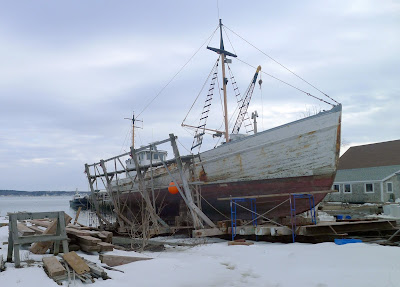I’m not much of a photographer, but this trip inspired me to try.
 |
| Sunset, approaching our home-away-from-home, the schooner American Eagle. |
The northeast’s best season is autumn, and we rolled into it while I was teaching aboard schooner American Eagle. Warm sun, blue skies, and light breezes meant that I kept telling myself, “I wish I could bottle this and save it for winter.” That, of course, is impossible. Instead, I soaked it up as well as I could.
 |
| Schooner Heritage soaking up the last of the sun at Pulpit Harbor. |
This was my last workshop of calendar year 2021. I’m pretty chuffed at how well all my students have painted all year, and this week has been no exception.
 |
| Tidal flats on an unoccupied island. The beach is washed clean twice a day. |
A photo is a poor approximation of an experience, but that and our memories are all we generally come home with. (Of course, my students also bring home paintings.)
 |
| The sky created crazy beautiful effects. |
I’m not much of a photographer to start with. I tend to snap and let the pieces fall where they may. I don’t generally even pick up my cell phone when I’m painting. That’s not a philosophy, it’s sheer cussedness. I’ve had to ask Ken DeWaard if he has pictures after we’ve painted somewhere together.
 |
| Lobsterboat coming home at dusk to Isleford harbor. |
This sailing trip was different. I came home with dozens of snaps on my cellphone. The sky constantly shifted its optical effects. Our fellow windjammers flew against a backdrop of blue-against-blue. Harbor porpoises wheeled alongside our boat. We stopped at Little Cranberry Island and walked its peaceful streets.
 |
| Bell buoy and the Bass Harbor Light. |
Next week, we start a new session of Zoom and plein air classes. If you meant to enroll but haven’t, I have limited openings:
- Monday nights, 6-9 PM EST, there is one seat left.
- Tuesday mornings, 10 AM-1 PM EST, there are three seats left.
- Local plein air, Thursday mornings, 10 AM-1 PM EST, there are many seats left.
If you want more information or to register, email me.
 |
| There are times when the ocean appears to be made of aluminum foil. |















